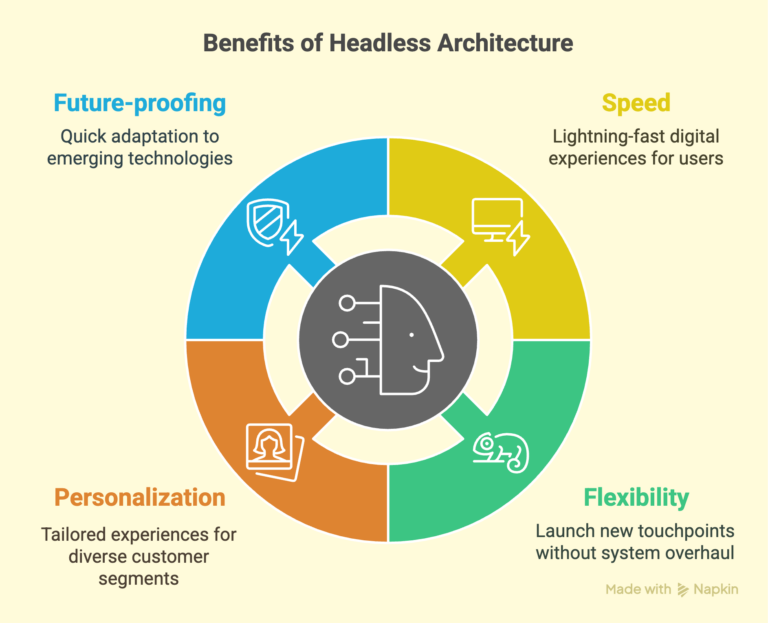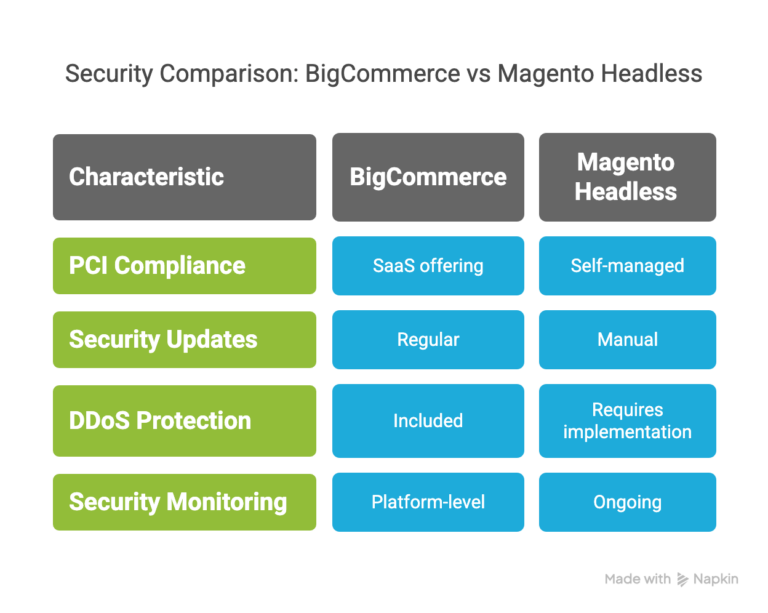Greetings! I'm Aneesh Sreedharan, CEO of 2Hats Logic Solutions. At 2Hats Logic Solutions, we are dedicated to providing technical expertise and resolving your concerns in the world of technology. Our blog page serves as a resource where we share insights and experiences, offering valuable perspectives on your queries.

Quick Summary
BigCommerce headless offers faster implementation, less complexity, and lower maintenance with some customization limitations. Magento headless provides maximum flexibility and customization but requires more technical resources and longer implementation timelines. The right choice depends on your specific business requirements, technical capabilities, and strategic priorities.
Ever find yourself stuck between choosing BigCommerce or Magento for your headless commerce project?
After implementing dozens of headless commerce solutions for clients at 2HatsLogic, we’ve seen firsthand how this decision can make or break your digital commerce strategy.
In this comprehensive guide, we’ll dive deep into the BigCommerce vs Magento headless comparison to help you make the right choice for your business needs.
What is Headless Commerce? A Quick Refresher
Before jumping into our BigCommerce vs Magento headless comparison, let’s make sure we’re on the same page about what headless commerce actually means.
Headless commerce separates your frontend (what customers see) from your backend (where business logic and data live).
This decoupling gives you tremendous flexibility to deliver seamless, personalized experiences across any customer touchpoint.
Why Go Headless in 2025?

- Speed: Headless architectures deliver lightning-fast experiences
- Flexibility: Launch new touchpoints without rebuilding your entire system
- Personalization: Create tailored experiences for different customer segments
- Future-proofing: Adapt quickly to emerging technologies and channels
Pro tip: When evaluating headless commerce platforms, consider not just your current needs but where your business will be in 3-5 years. The right architecture should grow with you.
BigCommerce vs Magento Headless: Core Capabilities
Let’s break down how these two powerhouses stack up in the headless commerce arena.
API Capabilities
| Feature | BigCommerce | Magento |
|---|---|---|
| API Type | REST, GraphQL | REST, GraphQL |
| API Coverage | Comprehensive | Extensive but complex |
| Rate Limits | More restrictive | More flexible with self-hosted |
| Documentation | Excellent, developer-friendly | Comprehensive but technical |
BigCommerce offers an impressive GraphQL API that covers nearly every aspect of your commerce operations. Their API-first approach makes them naturally suited for headless implementations.
Magento (now Adobe Commerce) brings equally powerful API capabilities but with a steeper learning curve. Their REST API has evolved significantly, and their GraphQL implementation continues to mature with each release.
Headless Implementation Complexity
When comparing BigCommerce vs Magento headless implementations, complexity is a crucial factor to consider.
BigCommerce’s headless approach is more straightforward to implement. As a SaaS platform, much of the infrastructure complexity is abstracted away, letting you focus on building great customer experiences.
For example, at 2HatsLogic, we recently helped a fashion retailer migrate from a monolithic platform to a BigCommerce headless solution. The entire implementation took just 12 weeks, significantly faster than comparable Magento projects.
Magento offers more customization potential but at the cost of higher complexity. Self-hosting means managing your own infrastructure, security, and scaling. This gives you ultimate control but requires more technical resources and expertise.
Total Cost of Ownership: BigCommerce vs Magento Headless
Understanding the total cost of ownership (TCO) is vital when evaluating BigCommerce vs Magento headless solutions.
BigCommerce operates on a SaaS model with predictable monthly fees based on your sales volume.
There are no hosting costs, maintenance fees, or unexpected infrastructure expenses. However, enterprise plans can become expensive as you scale.
Magento offers two options:
- Magento Open Source: Free to download but requires significant investment in hosting, security, and development
- Adobe Commerce (formerly Magento Commerce): Enterprise-grade with license fees plus hosting and implementation costs
When we analyze the 3-year TCO for our clients at 2HatsLogic, we typically find:
- For small to mid-sized businesses: BigCommerce headless is usually 30-40% less expensive
- For large enterprises: The costs become more comparable, with Magento sometimes offering better economics at scale
Performance and Scalability
Both platforms can deliver excellent performance in headless implementations, but there are important differences.
BigCommerce handles scaling automatically as part of its SaaS offering. During peak periods like Black Friday, their infrastructure absorbs the increased load without requiring merchant intervention.
Their BigCommerce headless implementation handled the surge flawlessly, while their previous monolithic platform would have crashed.
Magento gives you more control over performance optimization but requires expert configuration. Self-hosting means you’re responsible for scaling infrastructure during peak periods, which can be both a blessing and a curse.
Development Ecosystem
The development ecosystem is another important factor in the BigCommerce vs Magento headless debate.
BigCommerce has a growing community of headless developers, particularly those familiar with modern frontend frameworks like React, Vue, and Next.js. Their developer documentation is excellent, with plenty of examples and starter kits.
Magento boasts one of the largest commerce development communities in the world. While not all Magento developers are experienced with headless implementations, the overall ecosystem is vast and mature.
Ready to explore which headless commerce platform is right for your business?
Frontend Framework Compatibility
When implementing a BigCommerce vs Magento headless solution, frontend framework compatibility becomes crucial.
Both platforms work well with popular frontend frameworks:
- React: Both BigCommerce and Magento offer strong support
- Vue.js: Well-supported by both platforms
- Next.js: BigCommerce offers more comprehensive Next.js support
- Angular: Both platforms have community solutions
BigCommerce has invested heavily in frontend tooling, offering official starters for Next.js, Gatsby, and other modern frameworks. Their approach simplifies the development process for headless storefronts.
Magento’s PWA Studio provides tools for building progressive web applications, but it has a steeper learning curve. While powerful, it requires more specialized knowledge compared to BigCommerce’s approach.
Integration Capabilities
Modern commerce requires seamless integration with your broader tech ecosystem. Let’s see how BigCommerce vs Magento headless stacks up.
BigCommerce offers hundreds of pre-built integrations through their app marketplace. Their webhook system makes creating custom integrations straightforward, and their partner ecosystem continues to grow.
At 2HatsLogic, we recently connected a BigCommerce headless implementation with a complex ERP system, completing the integration in just three weeks.
Magento’s vast ecosystem includes thousands of extensions and integrations. While not all are optimized for headless implementation, the platform’s flexibility allows for virtually any integration to be built.
The key difference: BigCommerce typically offers simpler integrations with less development time, while Magento provides more customization potential at the cost of increased complexity.
Security Considerations
Security is paramount for any commerce implementation. In the BigCommerce vs Magento headless comparison, security models differ significantly.
BigCommerce handles most security concerns as part of its SaaS offering:
- PCI compliance
- Regular security updates
- DDoS protection
- Platform-level security monitoring
With Magento, security responsibility falls primarily on you:
- Self-managed PCI compliance
- Manual security patching
- Implementing proper security configurations
- Ongoing security monitoring

This fundamental difference means that BigCommerce typically requires less security expertise and overhead, particularly valuable for organizations without dedicated security teams.
Time to Market
How quickly can you launch? This is often a decisive factor when comparing BigCommerce vs Magento headless options.
Based on our implementation experience at 2HatsLogic:
- BigCommerce headless: Typical implementation takes 3-6 months
- Magento headless: A Typical implementation takes 6-12 months
This difference stems from BigCommerce’s more streamlined architecture and SaaS model, which eliminates many infrastructure and backend configuration challenges.
For example, we helped a B2B manufacturer launch their headless commerce store on BigCommerce in just 4 months, while a similar Magento project for another client took 9 months to complete.
Ready to accelerate your headless commerce project?
Customization Potential
When it comes to customization, the BigCommerce vs Magento headless comparison reveals important tradeoffs.
BigCommerce offers significant customization through its API but has certain platform limitations. You can’t modify core backend functionality, which occasionally restricts highly specialized business requirements.
Magento provides near-unlimited customization potential. With access to the source code, virtually any aspect of the platform can be modified to suit your specific needs.
This difference is particularly important for businesses with unique processes or requirements that don’t align with standard commerce patterns.
Support and Maintenance
Ongoing support and maintenance are critical considerations in any headless commerce implementation.
BigCommerce includes platform support and maintenance in its subscription fee. They handle:
- Infrastructure updates
- Security patches
- Platform upgrades
- Performance optimization

Magento requires you to manage these aspects yourself or through a partner. This includes:
- Server maintenance
- Security updates
- Version upgrades
- Performance tuning
For many organizations, particularly those with limited technical resources, BigCommerce’s support model represents significant value and reduced operational burden.
Making Your Decision: BigCommerce vs Magento Headless
After evaluating all these factors, how do you choose between BigCommerce vs Magento headless?
Consider BigCommerce headless if:
- Speed to market is critical
- You prefer predictable monthly costs over capital expenditures
- Your business fits mostly standard commerce patterns
- You have limited technical resources for ongoing maintenance
- You want to focus on customer experience rather than infrastructure
Consider Magento headless if:
- You have highly specialized or complex requirements
- You need complete control over your commerce infrastructure
- You have strong technical resources for development and maintenance
- You prefer to own your platform rather than rent it
- Your scale makes self-hosting economically advantageous
The right choice depends on your specific business needs, technical capabilities, and strategic priorities.
Conclusion
The BigCommerce vs Magento headless debate doesn’t have a universal winner. Each platform excels in different scenarios, and the right choice depends on your specific needs.
At 2HatsLogic, we’ve successfully implemented both platforms for our clients. Our approach is always to start with your business requirements and work backward to the right technology solution.
Need help deciding which headless commerce platform is right for your business? Our team of experts can guide you through the decision process and implement the perfect solution for your needs.
Contact 2HatsLogic today for a free headless commerce consultation
FAQ
Is BigCommerce truly headless?
Yes, BigCommerce offers comprehensive APIs (REST and GraphQL) that enable genuine headless implementations. Their API-first approach makes all core commerce functions accessible for custom frontend development.
Is Magento good for headless commerce?
Yes, Magento provides powerful APIs and flexible architecture for headless commerce. Its open-source nature gives developers complete access to customize both frontend and backend systems, though with increased complexity compared to SaaS options.
Which is easier to implement: BigCommerce or Magento headless?
BigCommerce headless implementations are generally faster (3-6 months) and less complex as infrastructure and security are handled for you. Magento implementations typically take longer (6-12 months) and require expertise in both frontend and backend development plus infrastructure management.
Can I migrate from traditional Magento to BigCommerce headless?
Yes, this is a common migration path. The process involves setting up your BigCommerce backend, migrating data, building your new headless frontend, testing thoroughly, and then switching over. This typically reduces total cost of ownership while improving performance.
Table of contents
- What is Headless Commerce? A Quick Refresher
- Why Go Headless in 2025?
- BigCommerce vs Magento Headless: Core Capabilities
- Total Cost of Ownership: BigCommerce vs Magento Headless
- Performance and Scalability
- Development Ecosystem
- Frontend Framework Compatibility
- Integration Capabilities
- Security Considerations
- Time to Market
- Customization Potential
- Support and Maintenance
- Making Your Decision: BigCommerce vs Magento Headless
- Conclusion

Related Articles






